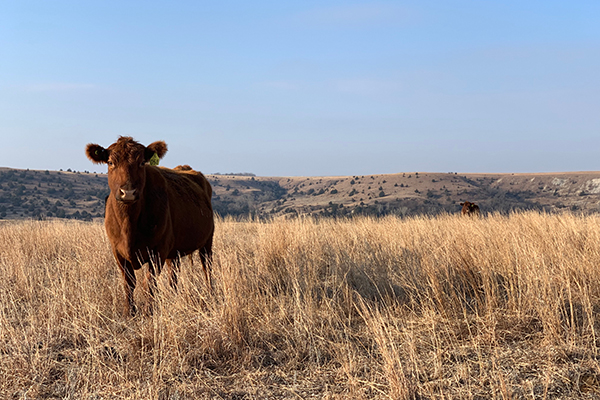Uncertainty in the cattle market is impacting every U.S. beef producer this fall. Like all sectors in agriculture, post-pandemic and supply-chain challenges are being further exacerbated by above- or near-record drought conditions. Extreme drought is no longer confined to the West, with tough conditions impacting Corn-Belt states, as well.
While many producers liquidate, total U.S. beef herd numbers continue to shrink, driving consumer prices higher and profitability per head higher for producers, even amidst sky-high feed costs.
“Cattle producers need water, and they need it now,” says Luke Schultz, Conterra Great Plains Region relationship manager. “But the cattle industry remains bullish on prices as less feeder calves hit the market.”
Like most market seasons, this one too, is temporary.
“Producers aren’t completely liquidating,” says Schultz. “Those still maintaining the core herd for genetics are going to see very profitable prices throughout the next 24 months.”
Bullish Cattle Market
Even as drought conditions perpetuate low cattle inventories, high value will be placed on cows, calves and yearlings throughout the next 12 months.
“It’s going to rain again and when it does, people will want to expand their herds and those heifers will be a hot commodity,” says Schultz, a Kansas Flint hills native and lifelong agriculturalist.
But how hot of a commodity can we expect replacement heifers to be? According to Mark Johnson, an Oklahoma State University beef cattle breeding specialist, medium and large frame muscle score 1 heifers are currently trading at $777 per head. Assuming these heifers are sold in May of next year and an average mature weight of 1,300 pounds, prices could look like $1,300 per head, all feed costs remaining equal.
However high price predictions go, Schultz says producers need to be watching their bottom line as current input costs present stress on any operation.
“Producers should ask how much they’re willing to spend to truck in hay and grains to get through the winter months,” says Schultz. “Budgets need to be penciled out for the next 12 to 36 months for producers to have a good snapshot of how they stand.”
Challenging feed conditions
Much of the uncertainty in the cattle market is due to extremely high feed costs. A recent USDA crop progress and conditions report showed that just under 39% of U.S. beef inventory is grazing on pasture or rangeland that is rated as poor or very poor. The hardest-hit states are also the states with the highest cattle inventories — Texas, Nebraska, Montana, South Dakota and Oklahoma.
Meanwhile, hay producers in those same states are struggling to produce an adequate crop due to the dry conditions. Producers should have a firm understanding of their cost of gain to calculate breakeven totals and plan for their operations long term.
But even as high feed costs and hard-to-find hay supplies weigh hard on producers’ wallets, domestic and global beef demand remains high. U.S. beef producers can offset the mental challenges that come with shrinking herds and high-priced inputs with the promise of an ever-growing world demand for quality beef products.
Working with your lender
Navigating through inventory and financial losses is tough enough without having to worry if your lender will see you through the long-term plan.
“If you’re used to talking with your lender once a month, it might be prudent to reach out twice a month,” says Schultz. “Be proactive and start a conversation so you help keep the partnership going through challenging times.”
Not all lenders will understand short-term loss for long-term gains, but every lender understands a balance sheet.
“At the end of the day, cash is king and you need equity,” reminds Schultz. “A good relationship with your lender can help a cattle producer in a tough situation.”
Schultz says Conterra lenders tend to value relationships first and the business second.
“We want to serve our clients,” he says. “We’ll ask ourselves, ‘based on what we’re looking at now, can this producer make it through the next 12 – 24 months or do adjustments need to happen?’”
With any economic downturn, equity in the balance sheet is critical. Schultz says it may not be the year to buy new equipment, as its important to watch expenditures when inputs are so high.
Ultimately, based on previous cattle cycles, historic highs in the feeder cattle market will likely be touched again in the next 24 months and could even reach new highs. Schultz says this long-term gain is worth buckling in and weathering the current cattle market uncertainty.
Work with Kansas-based Schultz and other qualified, ag lending experts by contacting Conterra for more information.
Disclaimer: Please note that the information provided in this article is for educational and informational purposes only, and should not be construed as financial or investment advice. While we have made every effort to ensure the accuracy and reliability of the information presented, Conterra Ag Capital and its affiliates make no representation or warranty as to the completeness, correctness, timeliness, suitability, or validity of any information contained in this article. You should always consult a qualified financial advisor, tax professional, or other qualified professional for advice on your specific financial situation.

